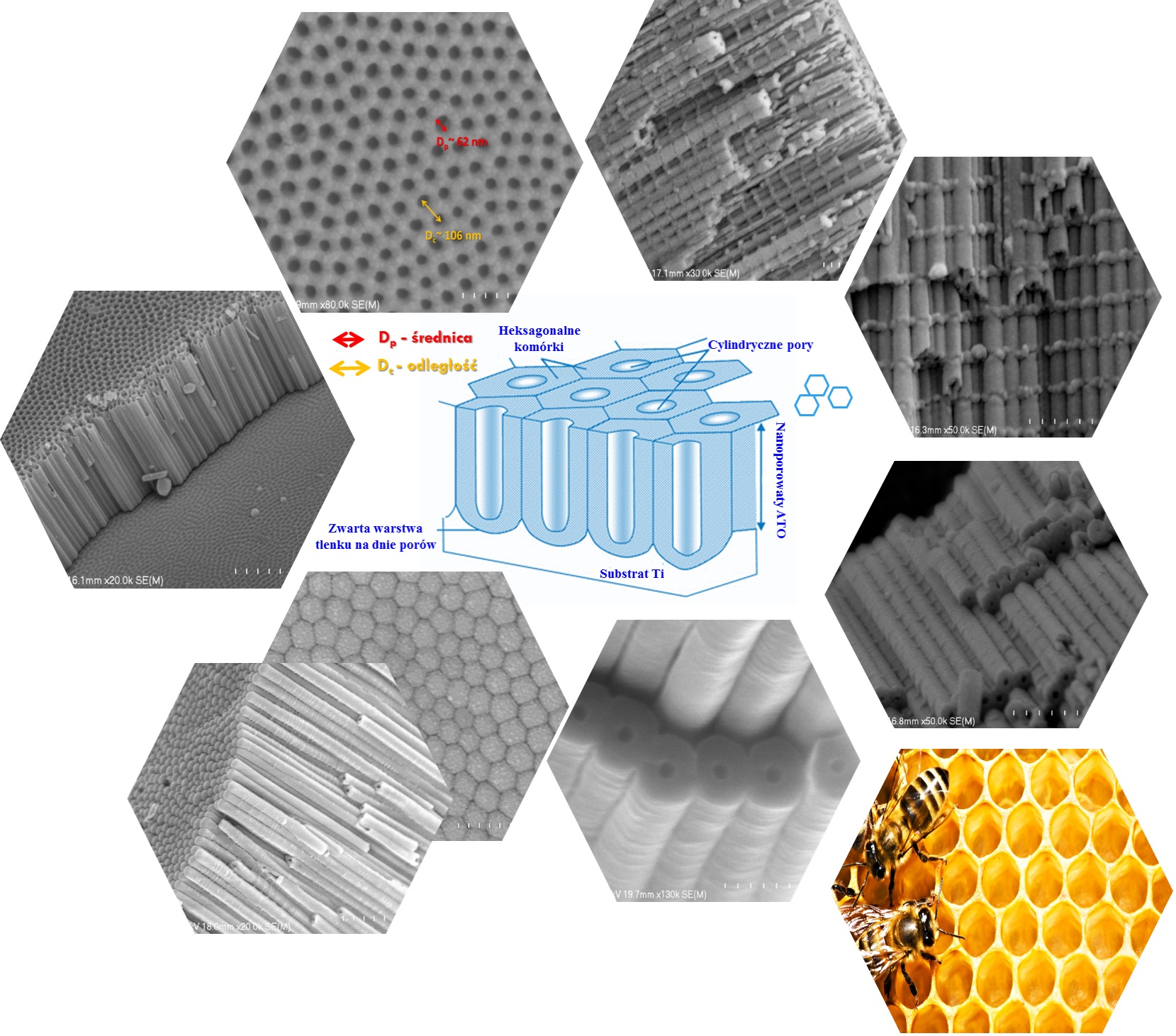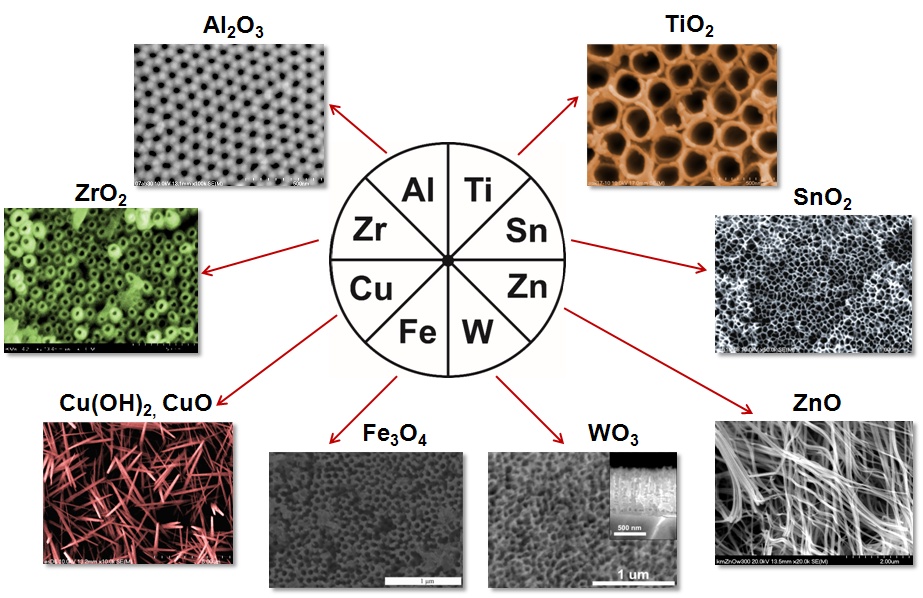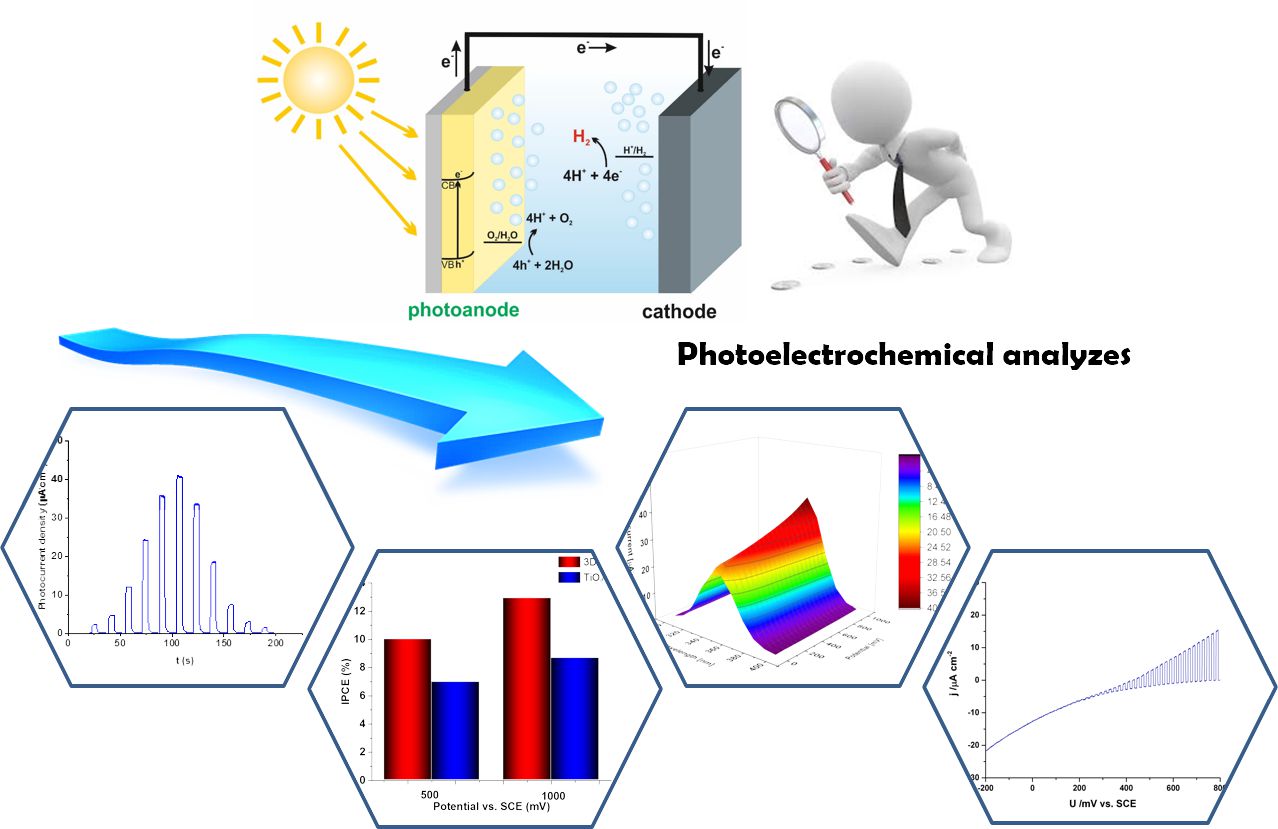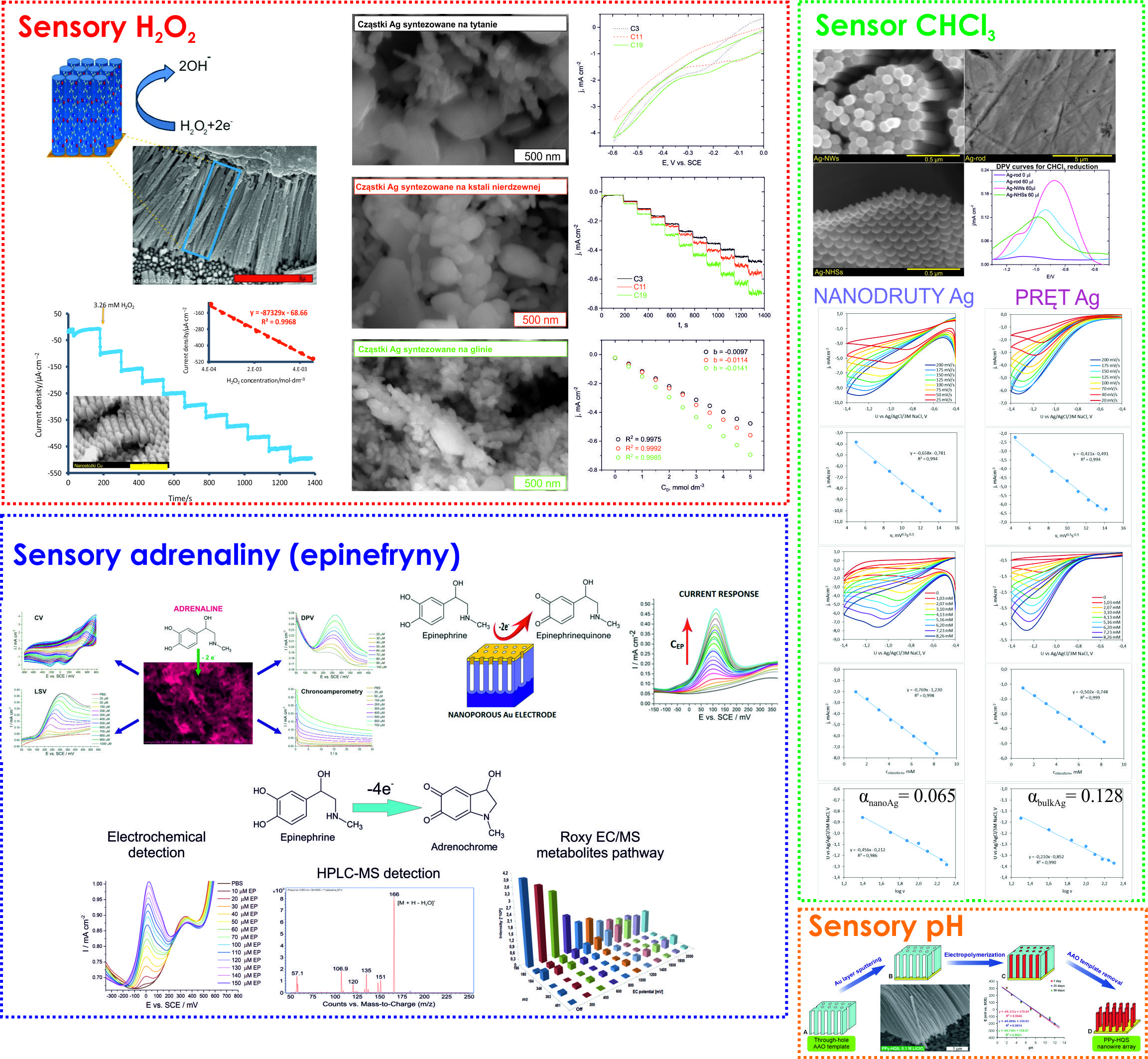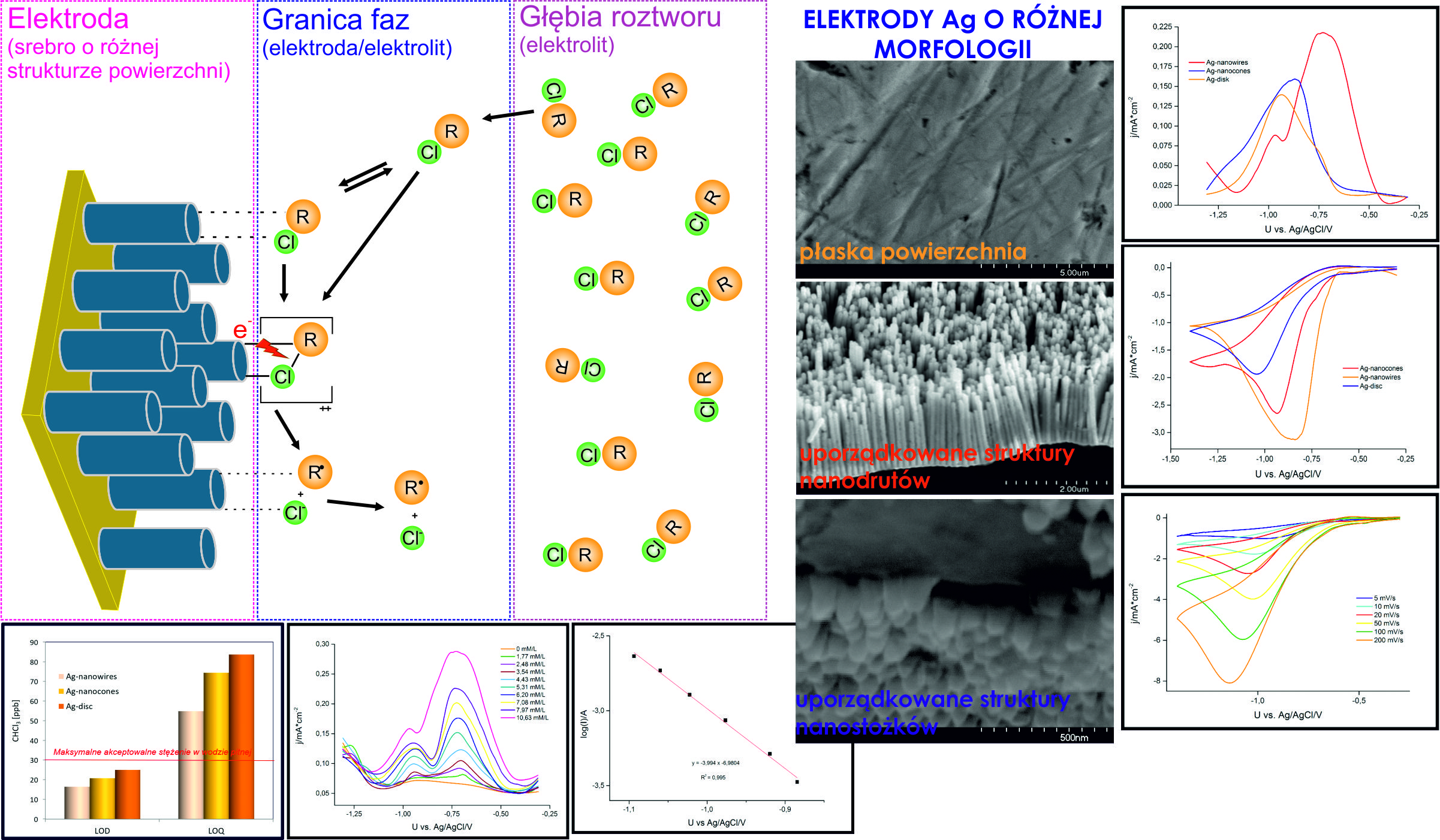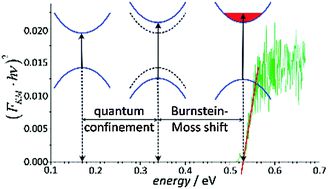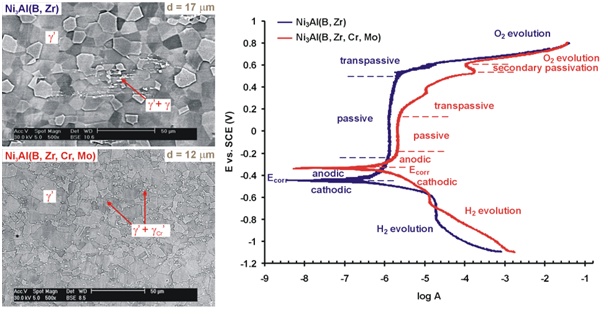ELECTROCHEMICAL SYNTHESIS OF NANOSTRUCTURED MATERIALS
FABRICATION OF NANOPOROUS ALUMINA BY ANODIC OXIDATION OF ALUMINUM IN ACIDIC ELECTROLYTES
Investigations on the effect of anodizing conditions on the structural features and pore arrangement of anodic alumina layers
Synthesis of nanoporous Al2O3 with modulated pore diameters via pulse anodization
Fabrication of through-hole nanoporous alumina membranes with straight and branched nanochannels
Synthesis of porous anodic alumina layers from technical Al alloys
Selected publications:
A. Brudzisz, G.D. Sulka, A. Brzózka, Through-hole AAO-SA templates with a small pore diameter prepared by the voltage pulse detachment method, Microporous Mesoporous Mat. 283 (2019) 73-81.
L. Zaraska, A. Brudzisz, E. Wierzbicka, G.D. Sulka, The effect of electrolyte change on the morphology and degree of nanopore order of porous alumina formed by two-step anodization, Electrochim. Acta 198 (2016) 259–267.
A. Brudzisz, A. Brzózka, G.D. Sulka, Effect of processing parameters on pore opening and mechanism of voltage pulse detachment of nanoporous anodic alumina, Electrochim. Acta 178 (2015) 374–384.
L. Zaraska, W.J. Stępniowski, M. Jaskuła, G.D. Sulka, Analysis of nanopore arrangement of porous alumina layers formed by anodizing in oxalic acid at relatively high temperatures, Appl. Surf. Sci. 305 (2014) 650–657.
L. Zaraska, G.D. Sulka, J. Szeremeta, M. Jaskuła, Porous anodic alumina formed by anodization of aluminum alloy (AA1050) and high purity aluminum, Electrochim. Acta 55 (2010) 4377–4386.
ELECTROCHEMICAL SYNTHESIS AND CHARACTERIZATION OF NANOPOROUS ANODIC TITANIUM OXIDE (ATO) LAYERS
Studies on the effect of anodizing conditions (e.g. potential, electrolyte, temperature) on the structural features and regularity of as obtained nanoporous/nanotubular structures
Fabrication of through-hole anodic titania layers via „potential shock” method
Synthesis of nanostructured titania with defined internal structure (straight, modulated, branched and bamboo-like channels)
Fabrication of 3D TiO2 nanopore/nanotube arrays
Synthesis and characterization of anodized Ti-based alloys
Selected publications:
J. Kapusta-Kołodziej, K. Syrek, G.D. Sulka, Synthesis and photoelectrochemical properties of anodic oxide films on titanium formed by pulse anodization, J. Electrochem. Soc. 165 (2018) H838-H844.
J. Kapusta-Kołodziej, K. Syrek, A. Pawlik, M. Jarosz, O. Tynkevych, G.D. Sulka, Effects of anodizing potential and temperature on the growth of anodic TiO2 and its photoelectrochemical properties, Appl. Surf. Sci. 396 (2017) 1119–1129.
M. Jarosz, K. Syrek, J. Kapusta-Kołodziej, J. Mech, K. Małek, K. Hnida, T. Łojewski, M. Jaskuła, G.D. Sulka, Heat treatment effect on crystalline structure and photoelectrochemical properties of anodic TiO2 nanotube arrays formed in ethylene glycol and glycerol based electrolytes, J. Phys. Chem. C 119 (2015) 24182–24191.
K. Syrek, J. Kapusta-Kołodziej, M. Jarosz, G.D. Sulka, Effect of electrolyte agitation on anodic titanium dioxide (ATO) growth and its photoelectrochemical properties, Electrochim. Acta 180 (2015) 801–810.
J. Kapusta-Kołodziej, O. Tynkevych, A. Pawlik, M. Jarosz, J. Mech, G.D. Sulka, Electrochemical growth of porous titanium dioxide in a glycerol-based electrolyte at different temperatures, Electrochim. Acta 144 (2014) 127–135.
ELECTROCHEMICAL SYNTHESIS OF NANOSTRUCTURED METAL (Sn, Zn, W, Zr, Cu, Fe) OXIDES WITH VARIOUS MORPHOLOGIES
Studies on the correlation between anodizing conditions and morphology, composition, and structure of as obtained nanostructures
Selected publications:
L. Zaraska, K. Gawlak, E. Wiercigroch, K. Małek, M. Kozieł, M. Andrzejczuk, M.M. Marzec, M. Jarosz, A. Brzózka, G.D. Sulka, The effect of anodizing potential and annealing conditions on the morphology, composition and photoelectrochemical activity of porous anodic tin oxide films, Electrochim. Acta 319 (2019) 18-30.
K. Syrek, L. Zaraska, M. Zych, G.D. Sulka, The effect of anodization conditions on the morphology of porous tungsten oxide layers formed in aqueous solution, J. Electroanal. Chem. 829 (2018) 106-115.
L. Zaraska, K. Mika, K. Syrek, G.D. Sulka, Formation of ZnO nanowires during anodic oxidation of zinc in bicarbonate electrolytes, J. Electroanal. Chem. 801 (2017) 511–520.
A. Pawlik, K. Hnida, R.P. Socha, E. Wiercigroch, K. Małek, G.D. Sulka, Effects of anodizing conditions and annealing temperature on the morphology and crystalline structure of anodic oxide layers grown on iron, Appl. Surf. Sci. 426 (2017) 1084–1093.
E. Wierzbicka, K. Syrek, G.D. Sulka, M. Pisarek, M. Janik-Czachor, The effect of foil purity on morphology of anodized nanoporous ZrO2, Appl. Surf. Sci. 388 (2016) 799–804.
FABRICATION OF NANOSTRUCTURED METALLIC (e.g. Ag, Au, Cu, Sn, Sb, Ni, Pd) AND POLYMER (e.g. PPY, PANI, PEDOT, PMMA) ELECTRODES BY USING POROUS ANODIC ALUMINUM OXIDE (AAO) TEMPLATES
Synthesis of straight, modulated and branched nanowire or nanocone arrays
Fabrication of porous nanowires by electrodeposition and selective dealloying
Selected publications:
A. Brzózka, K. Fic, J. Bogusz, A.M. Brudzisz, M.M. Marzec, M. Gajewska, G.D. Sulka, Polypyrrole-nickel hydroxide hybrid nanowires as future materials for energy storage, Nanomaterials 9 (2019) 307.
A. Brzózka, D. Szeliga, E. Kurowska-Tabor, G.D. Sulka, Synthesis of copper nanocone array electrodes and its electrocatalytic properties toward hydrogen peroxide reduction, Mater. Lett. 174 (2016) 66–70.
K.E. Hnida, R.P. Socha, G.D. Sulka, Polypyrrole-silver composite nanowire arrays by cathodic co-deposition and their electrochemical properties, J. Phys. Chem. C 117 (2013) 19382–19392.
L. Zaraska, E. Kurowska, G.D. Sulka, M. Jaskuła, Porous alumina membranes with branched nanopores as templates for fabrication of Y-shaped nanowire arrays, J. Solid State Electrochem. 16 (2012) 3611–3619.
G.D. Sulka, A. Brzózka, L. Liu, Fabrication of diameter-modulated and ultrathin porous nanowires in anodic aluminum oxide templates, Electrochim. Acta 56 (2011) 4972-4979.
APPLICATIONS OF NANOSTRUCTURED MATERIALS
PHOTOELECTROCHEMICAL AND PHOTOCATALYTIC APPLICATIONS OF NANOSTRUCTURED SEMICONDUCTING OXIDES
Investigation of the photoelectrochemical properties of as-received and modified nanostructured TiO2, WO3, SnO2, ZnO and other oxides.
Photoelectrochemical sensors for glucose detection based on nanoporous semiconducting oxides (e.g. WO3 and TiO2)
Electrochemical synthesis and morphological, structural, and photoelectrochemical characterization of hybrid Ti/TiO2/PEDOT material.
Photodegradation of pollutants on nanostructured TiO2 and WO3
Selected publications:
J. Kapusta-Kołodziej, A. Chudecka, G.D. Sulka, 3D nanoporous titania formed by anodization as a promising photoelectrode material, J. Electroanal. Chem. 823 (2018) 221-233.
K. Syrek, M. Zych, L. Zaraska, G.D. Sulka, Influence of annealing conditions on anodic tungsten oxide layers and their photoelectrochemical activity, Electrochim. Acta 231 (2017) 61–68.
J. Kapusta-Kołodziej, K. Syrek, A. Pawlik, M. Jarosz, O. Tynkevych, G.D. Sulka, Effects of anodizing potential and temperature on the growth of anodic TiO2 and its photoelectrochemical properties, Appl. Surf. Sci. 396 (2017) 1119–1129.
L. Zaraska, K. Syrek, K. Hnida, M. Bobruk, A. Krzysik, T. Łojewski, M. Jaskuła, G.D. Sulka, Nanoporous tin oxides synthesized via electrochemical anodization in oxalic acid and their photoelectrochemical activity, Electrochim. Acta 205 (2016) 273–280.
M. Jarosz, K. Syrek, J. Kapusta-Kołodziej, J. Mech, K. Małek, K. Hnida, T. Łojewski, M. Jaskuła, G.D. Sulka, Heat treatment effect on crystalline structure and photoelectrochemical properties of anodic TiO2 nanotube arrays formed in ethylene glycol and glycerol based electrolytes, J. Phys. Chem. C 119 (2015) 24182–24191.
NANOSTRUCTURED ELECTROCHEMICAL SENSORS
Hydrogen peroxide sensors based on Ag and PPy-Ag nanowire arrays, nanoporous Ag layers, Ag particles, and Cu nanocones
Chloroform sensor based on Ag electrodes with various morphologies
Adrenaline sensors based on Au nanowires and nanoporous thin layers
pH sensors based on polypyrrole nanowire arrays
Selected publications:
E. Wierzbicka, M. Szultka-Młyńska, B. Buszewski, G.D. Sulka, Epinephrine sensing at nanostructured Au electrode and determination its oxidative metabolism, Sensor Actuat. B–Chem. 237 (2016) 206–215.
A. Brzózka, D. Szeliga, E. Kurowska-Tabor, G.D. Sulka, Synthesis of copper nanocone array electrodes and its electrocatalytic properties toward hydrogen peroxide reduction, Mater. Lett. 174 (2016) 66–70.
E. Kurowska-Tabor, M. Jaskuła, G.D. Sulka, Sensitive amperometric sensing of hydrogen peroxide using Ag nanowire array electrode, Electroanalysis, 27 (2015) 1968–1978.
E. Kurowska, A. Brzózka, M. Jarosz, G.D. Sulka, M. Jaskuła, Silver nanowire array sensor for sensitive and rapid detection of H2O2, Electrochim. Acta 104 (2013) 439–447.
G.D. Sulka, K. Hnida, A. Brzózka, pH sensors based on polypyrrole nanowire arrays, Electrochim. Acta 104 (2013) 536–541.
ELECTROREDUCTION OF HALOGENOALKANES ON NANOSTRUCTURED METALLIC ELECTRODES
Investigation of the influence of the structure of the silver electrode surface on the electrocatalytic dehalogenation of chloroform.
Investigation of the influence of supporting electrolyte on the reduction potential and current density of reductive cleavage of a carbon-chloride bond in chloroform molecule.
Synthesis of AgPd nanowire array as a promising material towards electroreduction of halogenoalkanes.
Selected publications:
A. Brzózka, A. Jeleń, A.M. Brudzisz, M.M. Marzec, G.D. Sulka, Electrocatalytic reduction of chloroform at nanostructured silver electrodes, Electrochim. Acta 225 (2017) 574–583.
NANOSTRUCTURED THERMOELECTRIC MATERIALS
Synthesis and characterization of InSb – based nanowires and thin films
Electrochemical studies of In3+ and Sb3+ ions electrodeposition kinetics
Synthesis and characterization of InSb nanowires doped with Mn, Ga and Te via pulse electrodeposition
Selected publications:
D. Gilek, A. Brzózka, K.E. Hnida, G.D. Sulka, Electrochemical behavior of InSb thin films with different crystal structure in alkaline solution, Electrochim. Acta 302 (2019) 352-362.
K.E.Hnida, M. Marzec, E. Wlaźlak, D. Chlebda, K. Szaciłowski, D. Gilek, G.D. Sulka, M. Przybylski, Influence of pulse frequency on physicochemical properties of InSb films obtained via electrodeposition, Electrochim. Acta 304 (2019) 396-404.
K.E. Hnida, S. Bäßler, J. Mech, K. Szaciłowski, R. P. Socha, M. Gajewska, K. Nielsch, M. Przybylski, G.D. Sulka, Electrochemically deposited nanocrystalline InSb thin films and their electrical properties, J. Mater. Chem. C 4 (2016) 1345–1350.
K. Hnida, S. Baessler, L. Akinsinde, J. Gooth, K. Nielsch, R. Socha, A. Łaszcz, A. Czerwinski, G.D. Sulka, Tuning the polarity of charge transport in InSb nanowires via heat treatment, Nanotechnology 26 (2015) 285701
NANOPOROUS ANODIC TITANIUM DIOXIDE FOR BIOMEDICAL APPLICATIONS
Modification of nanoporous anodic TiO2 layers with silane derivatives and coating with polymeric (chitosan) layers.
The apatite-forming ability of modified nanoporous TiO2 layers.
Biological studies of TiO2/Ti scaffolds for cell culturing purposes.
Antibacterial properties of modified nanoporous anodic TiO2 layers.
Drug delivery systems based on nanoporous anodic oxides.
Mechanical and endurance studies of TiO2/Ti samples.
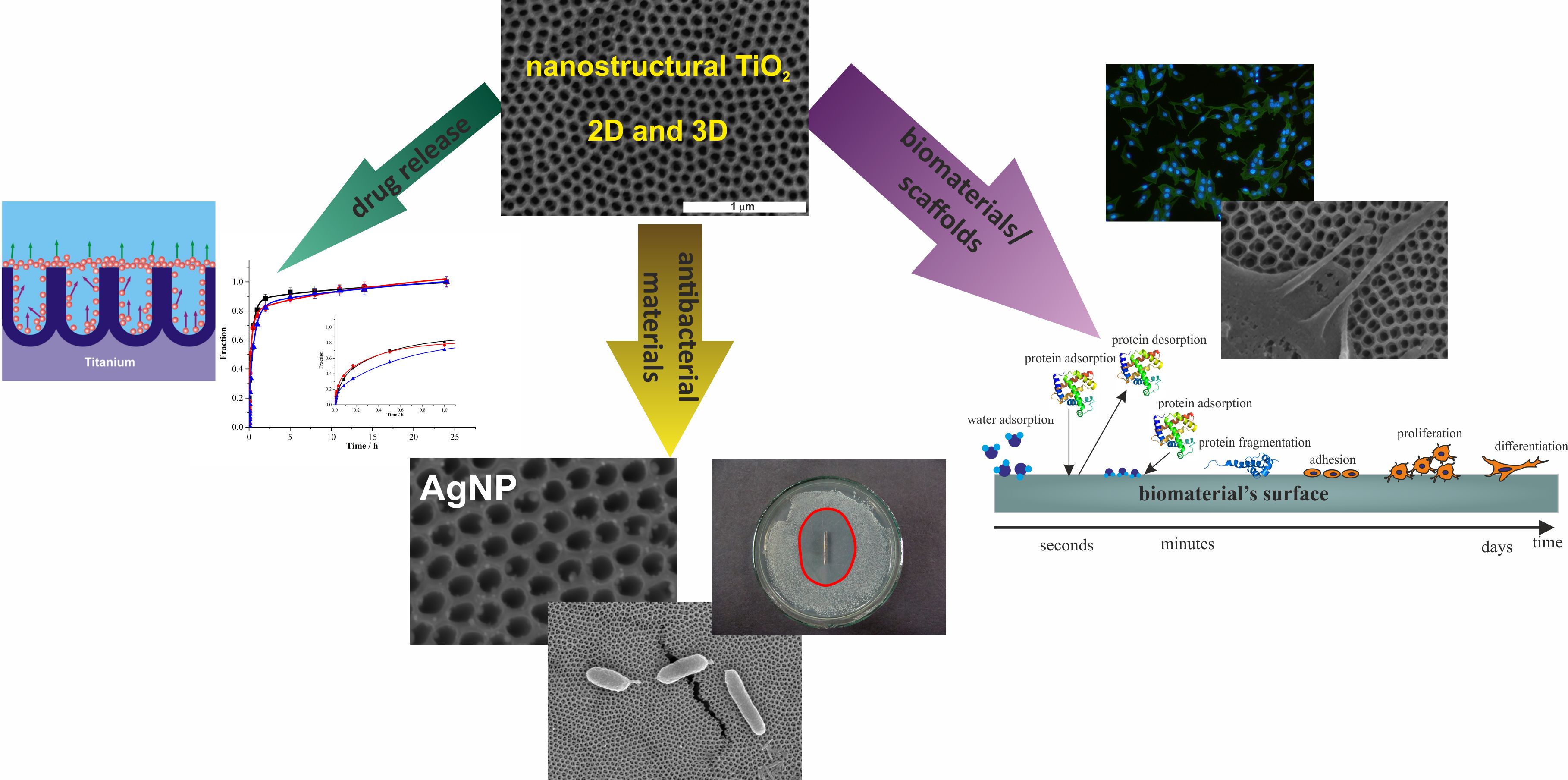
Selected publications:
A. Pawlik, M. Atiq Ur Rehman, Q. Nawaz, F.E. Bastan, G.D.Sulka, A.R.Boccaccini, Fabrication and characterization of electrophoretically deposited chitosan-hydroxyapatite composite coatings on anodic titanium dioxide layers, Electrochim. Acta 307 (2019) 465-473.
A. Pawlik, M. Jarosz, K. Syrek, G.D. Sulka, Co-delivery of ibuprofen and gentamicin from nanoporous anodic titanium dioxide layers, Colloids and Surfaces B: Biointerfaces 152 (2017) 95–102.
K. Malec, J. Góralska, M. Hubalewska-Mazgaj, P. Głowacz, M. Jarosz, P. Brzewski, G.D Sulka, M. Jaskuła, I. Wybrańska, Effects of nanoporous anodic titanium oxide on human adipose derived stem cells, Int. J. Nanomed. 11 (2016) 5349–5360.
M. Gołda-Cępa, K. Syrek, M. Brzychczy-Wloch, G.D. Sulka, A. Kotarba, Primary role of electron work function for evaluation of nanostructured titania implant surface against bacterial infection, Mater. Sci. Eng. C 66 (2016) 100–105.
M. Jarosz, A. Pawlik, M. Szuwarzyński, M. Jaskuła, G. D. Sulka, Nanoporous anodic titanium dioxide layers as potential drug delivery systems: drug release kinetics and mechanism, Colloids Surf., B 143 (2016) 447–454.
SUPERCAPACITORS
Polymer and Polymer-metal oxide nanowire arrays as future materials for energy applications –electrosynthesis, morphological, structural, and electrochemical characterization
Surface nanostructuring of metal foils (Ni,Cu) as a method of preparation the current collectors with improved adhesion properties
Selected publications:
A. Brzózka, K. Fic, J. Bogusz, A.M. Brudzisz, M.M. Marzec, M. Gajewska, G.D. Sulka, Polypyrrole-nickel hydroxide hybrid nanowires as future materials for energy storage, Nanomaterials 9 (2019) 307.
ELECTROLYTIC DEPOSITION AND DISSOLUTION OF METALS
Synthesis of nanoporous Au by selective etching of Au-Ag alloys
Synthesis of porous Ag by selective etching of Ag-Zn alloys
Selected publications:
E. Kurowska-Tabor, K. Gawlak, K. Hnida, M. Jaskuła, G.D. Sulka, Synthesis of porous thin silver films and their application for hydrogen peroxide sensing, Electrochim. Acta 213 (2016) 811–821.
E. Wierzbicka, G.D. Sulka, Nanoporus spongelike Au-Ag films for electrochemical epinephrine sensing, J. Electroanal. Chem. 762 (2016) 43–50.
G.D. Sulka, A. Brzózka, L. Liu, Fabrication of diameter-modulated and ultrathin porous nanowires in anodic aluminum oxide templates, Electrochim. Acta 56 (2011) 4972–4979.
P.T. Tang, M. Jaskuła, M. Kubiczek, I. Mizushima, K. Pantleon, M. Arentoft, Pulse reversal plating of nickel-cobalt alloys, Trans. Inst. Met. Finish. 87 (2009) 72–77.
G. Bech-Nielsen, M. Jaskuła, The influence of a magnetic field on the non-electrochemical dissolution of iIron, J. Electroanal. Chem. 624 (2008) 327–328.
CORROSION OF METALS AND ALLOYS
Studies on thin Ni3Al intermetallic alloys
Corrosion of TiNbZr, TiMo, and InSb
Selected publications:
G.D. Sulka, P. Jóźwik, Electrochemical behavior of Ni3Al-based alloys in NaOH, Intermetallics 19 (2011) 974–981.

